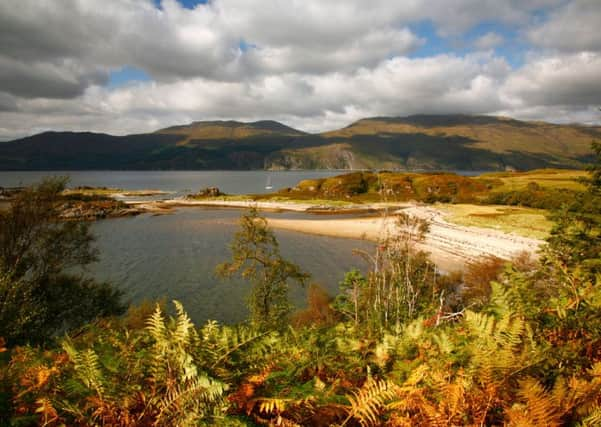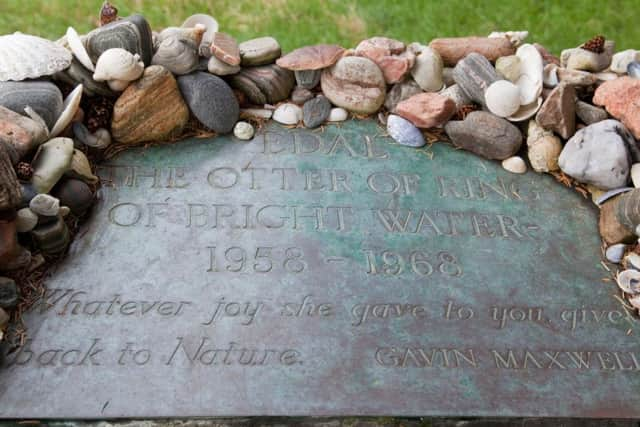Travel: Spirit of Camusfeàrna


Gavin Maxwell spent the last months of his life on Kyleakin Lighthouse Island and part of the myth will remain there, but it is more strongly linked with Sandaig – the place he called Camusfeàrna in his books. It is a place of pilgrimage for many. I first visited in 1985, the year I left school.
I decided I’d get the ‘Nightrider’ train up to Glasgow and then hitch-hike. Then I got cold feet. Hitching alone all that way? My head filled with images of homicidal maniacs and predatory men in macs. I phoned a friend. “It’s a bit last-minute, isn’t it?” But Dara wanted to get away as much as I did.
Advertisement
Hide AdWhen we reached Glenelg we bought supplies then pressed on uphill, climbed over a forestry gate and followed a track that circled through conifer forest until we came to the rough footpath that followed the burn down to the sea.


As we made our way through the trees we could hear water crashing in a ravine, and through a gap in the trees I glimpsed Sandaig and my heartbeat quickened. Black cattle were grazing down there, some of them standing up to their knees in the sea, waiting to cross to the chain of outlying islands.
Sandaig looked just as it had in the photos in the books I’d studied so often – a meadow ringed by the sea and a burn. Only the house, which had stood so prominent on the sea meadow, had gone.
I followed Dara down the mountainside to a fence and a makeshift stile. Two wrist-thick ropes, one above the other, stretched between alder trees on either side of the burn. We wobbled across, gripping the upper rope and sliding our boots along the lower one.
By the remnants of a dry-stone wall was a cairn with an engraved bronze plaque cemented on top of it: ‘Edal, the otter of Ring of Bright Water 1958-1968. Whatever joy she gave to you give back to Nature.’ People had placed shells and stones and dried flowers around the edges of the plaque. Beside the cairn, a rowan tree was dying while a nearby larch grew tall.
A well-beaten path led through long grass to a telegraph pole and a shoulder-high boulder. Here too was a plaque surrounded with offerings: ‘Beneath this stone, the site of Camusfeàrna, are buried the ashes of Gavin Maxwell.’
Advertisement
Hide AdThere were dunes covered with marram grass and a long stretch of sandy beach.
In the lee of the conifer-covered hillside that we’d descended was a tidy, whitewashed ‘butt ’n ben’ cottage – the ‘croft’. It had recently been painted. The windows and doorway had metal shutters locked in place over them. Black plastic piping ran from the direction of the burn to a tap wired to a post. Wooden fish boxes had been stacked nearby and covered with a pegged-down tarpaulin. A gargantuan wooden beam formed a natural bench, and I caught a glimpse of my projected future self sitting on it, living in the croft, alone or in company, no matter, and writing – just like Gavin Maxwell did.
Advertisement
Hide AdWe walked along the fence under the hillside. There was a barn, its stone walls crumbling, its corrugated-iron roof close to collapse. We came to a gap in the fence and from the roar I knew we’d found the waterfall. Maxwell had written a lot about the waterfall, and wrote much of Ring of Bright Water sitting up there beside it that summer of 1959, the year before his life changed forever. And he considered it to be the soul of Camusfeàrna.
Dara and I slipped on mossy rocks. Water crashed, drowning out all other sounds.
The barren conifers blotted out the sun. The waterfall roared in its gloom. Tree trunks, washed downstream by past torrents, lay stranded across its lip, damming the burn below. I felt watched. A trespasser. If a place can have a soul then Camusfeàrna, I think, has a troubled one.
We pitched our tent, out of the way of the midges and cattle, on an outcrop of rock that had a shallow basin of turf at the top of it. We gathered driftwood – mostly wooden fish boxes (there were many back then) – and lit a fire. The tide ebbed and uncovered a causeway of fine white sand. The black cattle lumbered through the shallows to browse the grassy islands beyond. Oystercatchers and ringed plovers and turnstones sped away from them, piping and peeping along the sands.
We stayed a week down at Sandaig. We paddled in the bays and caught crabs to grill over the fire. We waded through fat fronds of kelp in a transparent sea to the furthest island, where there was a locked Lilliputian lighthouse. We watched yachts anchor for the night in the bay before sailing away in the morning to leave us alone again. We frightened ourselves by sticking our heads under the icy flow of the waterfall, the cascading water blinding and deafening us to the dread presence we both felt watched us there. We spent hours playing cards, lying in our sleeping bags in the tent, waiting impatiently for bad weather to pass so that we could light a fire and cook. We sat to admire the gulls twist and cry and cavort; we watched seals bob and loaf and raise their dog-eyed heads to the heavens, and mistook them for otters because that was what we wanted them to be.
I visited Sandaig often after that, but always alone; the visits punctuation marks in my life. I swam, and explored the islands and found a way to the upper reaches of the burn, where there are other waterfalls and brighter, less soulful stretches of water. I collected wood and cooked my suppers on a fire and retired to my tent when it rained.
Advertisement
Hide AdYear by year things changed, as Nature reclaimed what was hers. Dara and I had found the rusting remains of the boat trailer of Maxwell’s launch, the Polar Star, among undergrowth by the wall by the burn. This disintegrated to dust and four perished tyres.
The twisted shell of a steel boat hull that I had first spied with a magnifying glass in one of the photographs in The Otters’ Tale sank further into the beach at the mouth of the burn. The rowan tree by Edal’s cairn rotted to nothing while the larch tree matured. The roof, and later the walls, of the barn collapsed. Only the totems placed around the plaques of the two gravestones remained, forever being blown away by the wind and replaced anew by fans.
Advertisement
Hide AdI still didn’t quite know why Maxwell appealed to me so strongly. But he kept coming back to haunt me. It was as though he had his own little shrine in my head. I’d forget about him, move along in life and then, out of nowhere, in a dream (I would be at Sandaig and everyone from the books would be there, except Gavin Maxwell, who was always away, absent, unavailable to see me) or a moment of emptiness, there he’d be, back on my mind again. I guess that is how obsession is.
• Island of Dreams: A Personal History of a Remarkable Place by Dan Boothby is published in hardback by Picador, priced £14.99 and in Ebook, £9.99, out now.